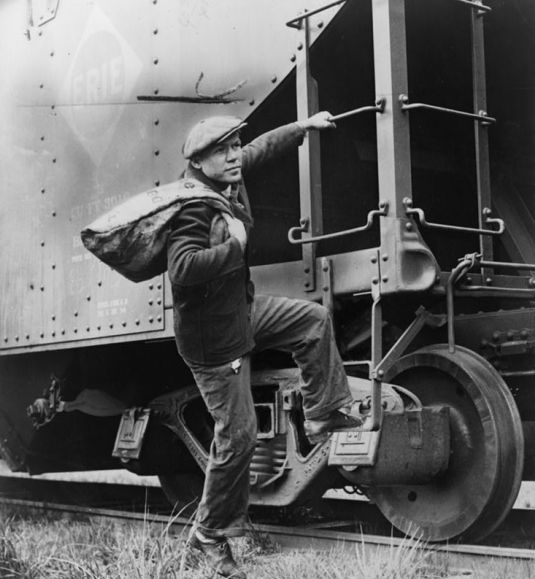
Thousands of acres of windborn soil bearing down on small town America during the 30s.
The year is 1931.
A massive drought sweeps through the Midwestern United States and after decades of deep and intensive tilling, catastrophe catches up. Farms left with little to no soil structure due to these aggressive agricultural practices are devastated after wind erosion begins stripping the very topsoil off of the earth. Colossal plumes of dust travel through the air, moving enormous amounts of soil and killing thousands of small-stead family farms.
The damage caused by the dustbowl effect was catastrophic, with millions being left jobless and thousands upon thousands of people losing their homes to the ecological devastation.
No home. No food. No jobs. What’s a person in rural America meant to do now?
Ride the Rails, My Boy!
Thus, the age of the American hobo dawns!

Boxer Lou Ambers prepares to stow away on a freight train with all his possessions in a satchel in 1935.
In response to the impact of the Depression and Dustbowl combined, millions of people begin migrating in search of work.
One of the easiest ways to travel long distances was to sneak into a railyard to catch a ride with outbound freight, but this was also fraught with peril. Jumping on to a moving train is dangerous at the best of times, and many people lost lives and limbs attempting to travel like this (not that it stopped anybody). Additionally, railyards would employ brutal security guards who came to be known as “bulls”. Violence was common, and to be caught by a bull could get you anything from thrown out, to broken bones and jail time.There was also the danger of coming into unfriendly towns, where hoboes could be beaten or driven out by people who viewed them as disgusting vagrants and thieves, which in a moment we’ll find to be somewhat ironic for a very important reason.
There existed a vagrant hierarchy, you see. A hobo is not a layabout beggar. A hobo is someone who travels specifically to find gainful employment. Conversely, a tramp is someone who will only work if forced to, and a bum is someone who won’t work at all. There was a certain pride in being a hobo in the 30s, and the infrastructure of many a town and the very rail lines the hobos rode on were often built by traveling hobo hands as folks moved to make a better life.

A handmade tapestry by “The Texas Madman”, made out of scrap denim documenting hobo symbols and parts of his life. These symbols are ones that he had used during his life on the rails and could often be found painted on buildings and rail bridges to inform other traveling hoboes of what to expect when entering a new town.
In between traveling, hoboes would often congregate in migrant camps at town outskirts known as Hobo Jungles. One of the biggest annual jungles is actually at the National Hobo Convention in Britt, Iowa. Once a town famously sympathetic to traveling hobos, it now houses a hobo museum with loads of hobo artifacts, a modest hobo graveyard where notable hoboes are buried, and the only nationally recognized celebration of hobo culture in the United States. Each year a Hobo King and Hobo Queen are crowned, a title they’ll hold until next year when I new set of hoboes step in.

Cooking Hobo Stew at a jungle camp. A little meat, canned vegetables and whatever else you could beg borrow and steal would all go in the pot, and the brave and foolhardy were always welcome to a bowl.
Lecture Summary
The last one! Is it kinda weird I’m sad to see them go? We covered a little smattering of everything for this final lecture, starting with a couple of peeks at early Vancouver (I had no idea the Guinness family was such a big deal in our history) to a little of the good ole’ Great Depression and beyond. The section on poster art of the time was a joy, with Cassandre’s Container Corporation of America poster being a huge standout I saved for later reference, I thought that was an incredibly striking design. Most of the poster design from the era is, to be honest. We touched a little more on figures like Raymond Loewy and Teague, James Northfield and wrapped with the rise of the Nazi regime of Germany!
Sourcing:
https://www.treehugger.com/sustainable-agriculture/dust-bowl-revisited.html
http://erroluys.com/greatdepressionarchive10.html
Don’t Call Them Bums: The Unsung History of America’s Hard-Working Hoboes

Leave a Reply